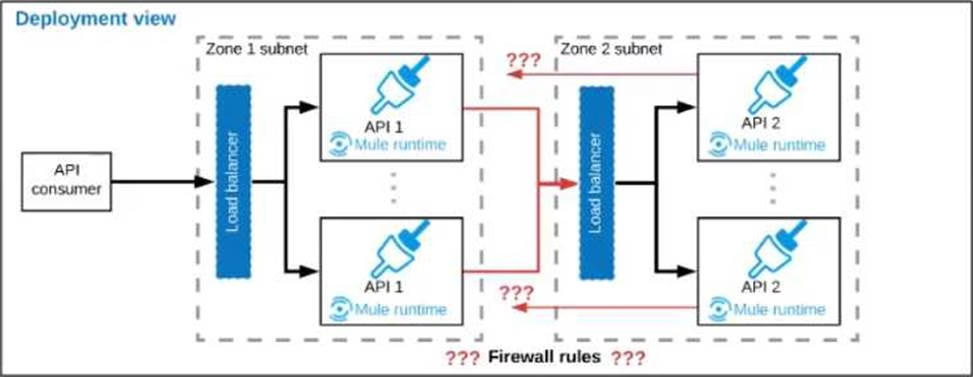In the network architecture, how must the firewall rules be configured to enable the above Interaction between API 1 and API 2?
Refer to the exhibit.


A business process involves two APIs that interact with each other asynchronously over HTTP. Each API is implemented as a Mule application. API 1 receives the initial HTTP request and invokes API 2 (in a fire and forget fashion) while API 2, upon completion of the processing, calls back into API l to notify about completion of the asynchronous process.
Each API Is deployed to multiple redundant Mule runtimes and a separate load balancer, and is deployed to a separate network zone.
In the network architecture, how must the firewall rules be configured to enable the above Interaction between API 1 and API 2?
A . To authorize the certificate to be used both APIs
B . To enable communication from each API’s Mule Runtimes and Network zone to the load balancer of the other API
C . To open direct two-way communication between the Mule Runtimes of both API’s
D . To allow communication between load balancers used by each API
Answer: B
Explanation:
* If your API implementation involves putting a load balancer in front of your APIkit application, configure the load balancer to redirect URLs that reference the baseUri of the application directly. If the load balancer does not redirect URLs, any calls that reach the load balancer looking for the application do not reach their destination.
* When you receive incoming traffic through the load balancer, the responses will go out the same way. However, traffic that is originating from your instance will not pass through the load balancer. Instead, it is sent directly from the public IP address of your instance out to the Internet. The ELB is not involved in that scenario.
* The question says “each API is deployed to multiple redundant Mule runtimes”, that seems to be a hint for self hosted Mule runtime cluster. Set Inbound allowed for the LB, outbound allowed for runtime to request out.
* Hence correct way is to enable communication from each API’s Mule Runtimes and Network zone to the load balancer of the other API. Because communication is asynchronous one
Reference: https://docs.mulesoft.com/apikit/4.x/configure-load-balancer-task
Latest MuleSoft Integration Architect I Dumps Valid Version with 244 Q&As
Latest And Valid Q&A | Instant Download | Once Fail, Full Refund

